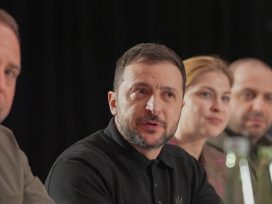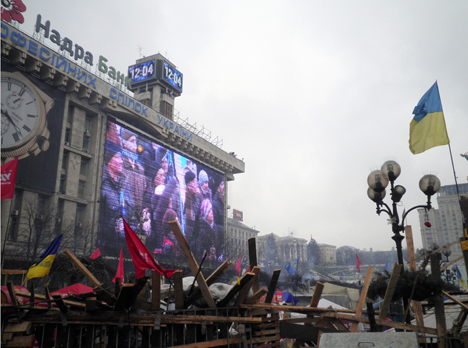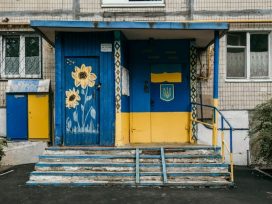
The ‘Trump–Putin deal’ again places Ukrainians in a subaltern role. The leaked contract with its fantasy $500 billion ‘payback’ has been compared to Versailles, but the US betrayal recalls nothing so much as Molotov–Ribbentrop.
The Internet and social media have so far provided a third of Ukrainians with digital connectivity. And, as a new era in Ukranian politics begins, new forms of sharing opinions will surely play their part in the struggle against what can now be called an ancien regime, writes Igor Lyubashenko.
I do not know whether the winged children of the Euromaidan, who still can’t stay firmly on their feet, can teach us how to fly. I hope they will teach some of us how to walk with our backs straight. And I am sure that they will help many get rid of the bad habit of creeping.
(Sergey Rahmanin, deputy editor-in-chief of the Zerkalo Nedeli weekly)
According to the most recent data provided by the International Telecommunication Union, about 34 per cent of Ukraine’s population use the Internet. This number has grown dynamically over the last years. Not surprisingly, the Internet audience is dominated by the young. Furthermore, in 2013, GFK Ukraine reported that social networking had become the most popular online activity among Ukrainians.

Euromaidan, Independence Square, Kyiv on 19 December 2013. Photo: Jose Luis Orihuela. Source:Flickr
This information may not be the most exciting data, especially if we take into account that general patterns of Ukrainians’ online activities do not differ significantly from other countries. Access to the Internet does not increase society’s general interest in politics. Furthermore, much has been written about the possible negative effects of the Internet on democracy and democratization.
On the other hand, the Internet and social media have provided a significant number of Ukrainians with something more than mundane possibilities to share photos of favourite cats or raise jealousy among friends by “checking-in” at cool restaurants and clubs. It provided one-third of Ukrainians with digital connectivity. It triggered the process of changing the very structure of Ukraine’s society and facilitated its transformation to what is described in the literature as a network society. From this perspective, its most important features include new communication patterns, which are decentralized, customizable and less oriented on traditional authorities.
According to the latest study by Manuel Castells, a theorist of the network society (Networks of Outrage and Hope: Social Movements in the Internet Age, Polity Press, 2013), for a social movement to form in this new type of society, two things should happen: a cognitive consonance (similar assessment of reality by a significant number of individuals) and an effective communication channel, creating a sort of resonance chamber where individuals can share their emotions.
The Euromaidan movement (utilising the hashtag #euromaidan) started on 21 November 2013, when the government of Ukraine declared its decision to postpone the process of signing the long-negotiated Association Agreement with the EU – just one week before Eastern Partnership Summit in Vilnius. This fact is cited as proof that the goal of the protest is to support Ukraine’s further integration with the EU. However, such an interpretation is an oversimplification. The notion of a country’s “European future” is too vague to drive a mass social movement that would be ready to occupy the public space for a long period of time. Furthermore, Ukrainians’ perception of European integration is complex. One should not forget that the process of negotiations over the Association Agreement was rocky, and even on 20 November 2013 the openness of “European doors” for Ukraine was far from obvious. The roots of society’s dissatisfaction should be sought deeper.
The core of the narrative that grouped the minds of the protesters is dissatisfaction with the general situation in the country. A recent opinion poll showed that 65 per cent of respondents were sure that the developments in Ukraine were heading in the wrong direction (Razumkov Center, October 2013). President Viktor Yanukovych continued to be the most popular candidate for the presidency ahead of 2015, but only 19 per cent of voters declared support for him and the rest of the potential candidates gained even less trust. The situation was predominantly described as social apathy and growing alienation between the political class and ordinary citizens. Looking from today’s perspective, it would probably be more appropriate to characterize the situation as a growing level of frustration, especially among young, educated people facing political stagnation and the difficult economic situation in the country.
As for communication, digital channels played a primary role in the whole process. According to public opinion polls, only 43 per cent of Ukrainians declared their trust in traditional media, while 36 per cent announced their distrust in it (Razumkov Center, March 2013). For about 21 per cent of Ukrainians, the Internet has become the primary source of information (Democratic Initiatives Foundation, June 2013). Online media was the first to inform the public about the government’s decision on the Association Agreement. According to Watcher, a web portal devoted to Internet-related issues, this led to the highest levels of visits to Ukrainian news sites in the history of its research. The first calls to conduct a demonstration appeared in social media, particularly on Facebook. The specificity of the Ukrainian segment of this social networking site is that it is used by a number of popular opinion-makers as a sort of blogging and community-building platform. The message spread quickly and the reaction was immediate.
The people gathered in the centre of Kyiv in the evening of the same day. During the next few days, “Euromaidans” appeared in many Ukrainian cities and towns. The technology of video streaming, allowing a constant view right from the centre of events, was essential. The mix of these digital communication technologies created a network of resonating opinions that finally led more and more people into the streets.
According to Castells, the peaceful character of a networked social movement depends largely on the reaction of the authorities. The decision to disperse a peaceful demonstration in Kyiv’s Independence Square on the morning of 30 November should be regarded as the most important milestone in the development of the movement. Once again, digital communication played a crucial role here. Online media and text messaging became instantaneous channels of spreading the news. The riot police action took place at 4:00 am and, by 9:00 am, communication in social media was focussed on this event.
Even superficial observations of the dynamics of the online conversations taking place in Ukraine showed the quick evolution of its emotional load. The first messages were full of concerns: “We went to sleep in Ukraine and woke up in Belarus.” Very soon, fear was replaced with anger and a call to action and participation in mass protests on 1 December. The violent reaction of the state has thus enforced the movement’s counter-narrative of alienating authorities not in line with citizens’ opinions. The scale of protests on 1 December confirmed that rage outweighed fear, to large extent thanks to resonating effects of opinion sharing provided by digital connectivity.
On the other hand, the reactions of the authorities led to a significant change in the nature of the movement. While the demonstrators at Euromaidan were distrustful towards politicians since its inception, the crackdown opened up for the participation of opposition leaders on 1 December. Its long-term goals and vague slogans of a European future sharpened into precise demands that the government and president resign. From this perspective, 30 November 2013 became the point of no return for Ukraine’s networked revolt in the sense of its explicit politicization.
The period between 21 November and 1 December marks the beginning of a new era in Ukrainian politics. It is now possible to say with confidence that one of the main things that took place was the political initiation of the new generation of the country’s citizens. It is they – students, young people who do not remember life in the Soviet Union – who became the critical mass for the movement. This generation does not differ much from its foreign counterparts. It is not interested in politics, it is predominantly not interested in ideas, it is often focussed on consumerism and simple amusements (of course, these are generalizations, not necessarily referring to particular Ukrainian young people). It showed, however, that it is able to respond when politicians try to outline their future without their agreement, closing the way to what is perceived as a source of a high-quality, comfortable life. It is a connected generation, not trusting of traditional authorities. Whoever will hold power in Ukraine in the years to come will have to learn how to legitimize his or her authority in the eyes of this generation, how to translate traditional narratives into language understood and accepted by this generation. It will not be an easy task; there are no simple recipes. Ukraine has entered the era of post-politics.
It is important to emphasize that the change should not be evaluated as simply “good” or “bad”. It will go on despite our opinion. What is essential is that we understand its essence in order to apply it in our further attempts to analyse the Ukrainian political reality.
Unfortunately, this change does not provide an analytical framework to foresee further developments in Ukraine. The politicization of the Euromaidan movement means that it started as a struggle against what can be called an ancien regime. Borderlines between the old and the new will not always be obvious, but unless the country takes an extremely non-democratic path of development, the new rules of the game will spread.
Published 10 January 2014
Original in English
First published by New Eastern Europe 1/2014
Contributed by New Eastern Europe © Igor Lyubashenko / New Eastern Europe / Eurozine
PDF/PRINTSubscribe to know what’s worth thinking about.

The ‘Trump–Putin deal’ again places Ukrainians in a subaltern role. The leaked contract with its fantasy $500 billion ‘payback’ has been compared to Versailles, but the US betrayal recalls nothing so much as Molotov–Ribbentrop.

Ukraine faces its greatest diplomatic challenge yet, as the Trump administration succumbs to disinformation and blames them for the Russian aggression. How can they navigate the storm?